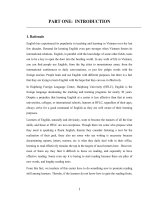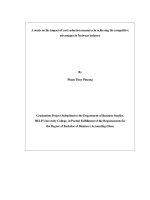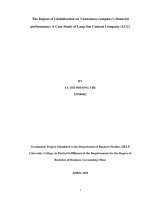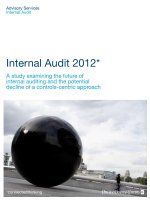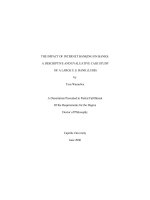A study on the impact of foreign direct investment on economic development of lao p d r (sum)
Bạn đang xem bản rút gọn của tài liệu. Xem và tải ngay bản đầy đủ của tài liệu tại đây (171.45 KB, 12 trang )
MINISTRY OF EDUCATION
LAOS NATIONAL UNIVERSITY
MINISTRY OF EDUCATION AND TRAINING
NATIONAL ECONOMICS UNIVERSITY
KHAMSEN SISAVONG
A STUDY ON THE IMPACT OF FOREIGN DIRECT INVESTMENT ON
ECONOMIC DEVELOPMENT OF LAO P.D.R.
(Development Economics)
Code:
62.31.01.05
A dissertation summary submitted to the National Economics University
in fulfillment of requirements for the degree of
Doctor of Philosophy in Economics
Hanoi, 2014
2
CHAPTER 1: INTRODUCTION
1.1 Research Background
Laos is a small landlocked country with an area of 236,800 square
kilometers. It shares its borders with Vietnam in the East, China in the
North, and Cambodia in the South, Thailand and Myanmar in the west.
Two third of the country is mountainous (northern part) thus its geographic
circumstances constrain both the quality and quantity of agriculture and
cause difficulties to the development of trade, social infrastructure and
transportation and communication links. However, the country has
transformed from a landlocked to a land link and cross road to other parts
of the world.
In 1986, the Lao government implemented the New Economic
Mechanism (NEM) to open the country and provided incentives for
developers and investors and moved from a centrally planned economy to a
market oriented economic model.
FDI inflows in Laos have grown dramatically over the past decade
and have played an important role in the growth of the world economy as
well as the ASEAN Nations. In the developing world, FDI has become the
most stable and largest component of capital flows. As a result, FDI has
become an important alternative in the development finance process
(Global Development Finance, 2005.)
Laos is a small and still poor country. Therefore, the investment from
foreign countries in terms of FDI is needed because FDI plays an important
role in job creation, economic growth, capital inflow, technology transfer,
human resource development, and wealth in the host country. Thanks to the
economic reform, the number of FDI projects and the income on
international trade have increased significantly and have had a direct
impact on national income as well as GDP growth.
3
1.2 Rationale for the Research
It has been suggested that Foreign Direct Investment (FDI) inflows
have played an important role in promoting economic growth in developing
countries, especially in the Southeast Asian countries (Nguyen, 2008).
Given the importance of FDI especially in developing countries like
Laos, theoretically as well as practically, there are however still
inconclusive arguments for and against the role of FDI inflows in
enhancing economic development in a country (cf., Nguyen, 2008). It has
still been debate about whether FDI inflows are beneficial or not to
economic development, and what governments should do to attract and use
FDI inflows effectively (Kokko et al., 2003; Longani & Razin, 2001;
Masina, 2002; Nguyen, 2008). In addition, it has been suggested that the
relationship between FDI and economic growth may be country and period
specific (cf., Adegbite & Ayadi, 2010). Therefore, this study aims to
explore the impact of FDI inflows on some indicators of economic
development in the context of Laos, a developing country in Asia.
1.3 Research Objectives and Research Questions
This study seeks to analyse FDI inflows into Laos and to investigate
their impact on the economic development of Laos. The desired outcome of
this research aims at confirming the linkage between FDI inflows in Laos
and the economic development indicators including GNI per capita,
financial capital, level of technology, human capital, energy and natural
resources, transportation and communication.
This research tried to answer the questions: 1) What are the relevant
literature and the theoretical background on FDI and its impact on
economic development? and 2) Does FDI have a significant contribution to
economic development of Laos?
With regard to the impact of FDI on economic development, the
research aims to answer the following specific questions:
4
• Does FDI have a significant role on the GNI per capita?
• Does FDI have a significant role on the Financial Capital?
• Does FDI have a significant role on the country's level of technology
of Laos?
• Does FDI have a significant role on Human Capital of Laos?
• Does FDI have a significant role on the Energy and Natural
Resources availability of Laos?
•
Does FDI have a significant role on the Transportation and
Telecommunication infrastructure of Laos?
1.4 Scope of the Study
This study focuses on the role of FDI on some indicators of
economic development in the context of Laos. Other aspects of
development such as social and environmental issues (i.e., poverty ratios of
different sectors, education and health care, environment pollution and
damage) are not addressed in this dissertation.
This study mainly employed the data to analyse the relationships
between FDI and Laos’ economic development indicators during the period
1990-2012. The analyses of correlations were used to serve the objectives
of this research.
1.5 Contributions of the Study
This study aims to examine the impact of FDI on several economic
development indicators in the context of Laos. The study is important to
help Laos enjoy further economic development as well as contributes to the
literature of FDI and economic growth in the context of developing
countries.
FDI has been suggested as a determinant of economic development
in both developed and developing countries. Its important role in promoting
5
economic growth and bringing many benefits to the economy is especially
emphasized in the context of developing countries. However, the literature
also provides mix findings pertaining to the effects of FDI, and there has
been suggested that the link between FDI and economic development may
be country and period specific. Therefore, it is important and meaningful to
examine the impact of FDI inflows on economic development in Laos, a
developing country which has received very modest research attention to
date.
By focusing on six main research questions pertaining to the
relationships between FDI inflows and various indicators of economic
development, the research has contributed to both theoretical and practical
sides. From theoretical perspective, the research helps to enrich the
knowledge about the important topic pertaining to FDI’s impacts on
economic development in general and in the context of a developing
country in particular. From practical perspective, the research findings
provide significant implications to policy makers in Laos.
The issue of FDI and its important role is more important for
developing countries and the countries in transition like Laos because they
lack capital, know how, and managerial skills. Understanding the role of
FDI would help making good policies to attract more FDI for the purpose
of economic development.
1.6 Dissertation Structure
This dissertation includes six main chapters as follows.
Chapter 1: Introduction
Chapter 2: Literature review on the impact of FDI on economic
development
Chapter 3: Overview of economic development and FDI in Laos
Chapter 4: Research methodology
6
Chapter 5: Research findings
Chapter 6: Conclusions and discussion
7
CHAPTER 2: LITERATURE REVIEW ON THE IMPACT OF FDI
ON ECONOMIC DEVELOPMENT
This chapter reviews the literature on IJVs’ performance and the
factors influencing it. In the first section of the chapter, the literature on the
five common measures of IJV performance were reviewed, followed by the
review of the key determinants of IJV performance. Finally, the proposed
conceptual framework is presented.
2.1 Definition and Indicators of Economic Development
2.1.1 Definition of Economic Development
Economic development is a normative concept. It means that it
applies in the context of people's sense of morality (right and wrong, good
and bad). The definition of economic development given by Todaro (1994)
is an increase in living standards, improvement in self-esteem needs and
freedom from oppression as well as a greater choice. The most accurate
method of measuring development is the Human Development Index which
takes into account the literacy rates and life expectancy which affect
productivity and could lead to economic growth. It also leads to the
creation of more opportunities in the sectors of education, healthcare,
employment and the conservation of the environment. It implies an
increase in the per capita income of every citizen (Todaro, 1994).
The terms economic development and economic growth are used
interchangeably but there is a big difference between the two. Economic
growth can be viewed as a sub category of economic development.
Economic development refers to government policy to increase the
economic, social welfare and ensure a stable political environment.
Economic growth on the other hand refers to the general increase in the
country products and services output (source: whatiseconomics.org).
8
2.1.
2
Indicators of Economic Development
In literature, previous studies have examined various aspects of
economic development. In this study, the author examines the impact of
FDI on economic development in Laos, focusing on some economic
development indicators including:
- Gross National Income (GNI) per capita
- Financial Capital
- Level of technology
- Human Capital
- Energy and Natural resources
- Transportation and Communication
2.1.3 Theoretical Economic Overview
This section review several economic models such as Lewis' Dual
Economy model (1954), Solow's model (1956), the Harrod-Domar growth
model, and Dependency theory (Pool & Stamos, 1990).
2.2 FDI and its Impact on Economic Development
2.2.1 Definition and Determinants of FDI
2.2.1.1 Definition of FDI and reasons for FDI inflows to developing
countries
FDI is defined as cross-border investment by a resident entity in one
economy with the objective of obtaining a lasting interest in an enterprise
resident in another economy. The lasting interest implies the existence of a
long-term relationship between the direct investor and the enterprise and a
significant degree of influence by the direct investor on the management of
9
the enterprise. Ownership of at least 10% of the voting power, representing
the influence by the investor, is the basic criterion used (OECD, 2012).
In the same line, according to investopedia.com, FDI refers to an
investment made by a company or entity based in one country, into a
company or entity based in another country.
Yoonbai (2000) examined the reasons behind the flow of FDI in
countries like Korea, Malaysia, Chile, and Mexico. The research found that
this flow was influenced by two factors on a global level: recessions faced
by many industrialized economies and the global interest rate drop. Internal
factors like (a) country-specific productivity shocks, (b) demand shocks,
(c) inflation shocks,(d) monetary shocks, (e) credit worthiness because of
macroeconomic stabilization, (f) widespread liberalization of financial
market, and (g) a successful resolution of debt problems were found
relatively less important.
2.2.1.2 Determinants of FDI
There have been a number of theories and approaches that help
explain the motivations of FDI and identify FDI’s determinants.
- Internalization
- Eclectic paradigm
- Complement Theory of FDI
- The Resource-Based Theory
- The Theory of New Economic Geography
- Diversified FDI and risk diversified model
- Policy determinants of FDI
2.2.2 Impact of FDI on economic development
In this section, first the author review previous studies on the impact
of FDI on economic growth and some other aspects of economic
10
development, mainly in the context of developing countries. After that, a
review of the studies on the impact of FDI on economic development
through human capital and technology is provided. Finally, the author
presents FDI and its spillover effects.
2.2.2.1 Impact of FDI on economic growth and other economic
development aspects
2.2.2.2 Impact of FDI on Economic Development through Human Capital
2.2.2.3 Impact of FDI on Economic Development through Technology
2.2.2.4 Foreign Direct Investment and Spillovers
11
CHAPTER 3: OVERVIEW OF ECONOMIC DEVELOPMENT AND
FDI IN LAOS
3.1 Overview of Laos’ Economy
This section presents various aspects of Laos’s economy, inclusing
economic growth, economic structural changes, etc.
3.1.1. Economic growth
On average, the Gross Domestic Product (GDP) during the Sixth
Plan period was 219,853 billion kip, approximately 43,970 billion kip per
year. GDP grew at an annual rate of 7.9%, which was higher than the Sixth
Five-Year Plan target (the plan target was 7.5%). In FY 2009-2010, the
value of GDP was 54,282 billion Kip which was 1.89 times higher than FY
2004-2005. The growth in share of agriculture in GDP was 4%, of industry
was 12.6%, and of services was 8.4%.
3.1.2 Economic structural changes
The economic structure has changed as an economy transforms from
a subsistence agriculture economy based on raw materials to a market-
oriented economy based on processing.
3.1.3 Financial sector growth
During the past years, the banking sector has contributed to financial
stability, and the foreign exchange rate has remained stable. This is
reflected in the money supply growth at 23% per year which contributed
to19.6% of GDP. Foreign exchange grew and contributed to approximately
35% of GDP in 2009-2010. An increase in the money supply or M2 was
contributed by the increasing numbers of foreign investors.
12
3.1.4 Banking sector development
The banking sector is one of the sectors that grew rapidly and
distinctly during the period of the Sixth Five-Year Plan.
3.1.5 Inflation has been effectively managed
3.1.6 The appreciation of the Kip currency
3.1.7 Workforce and employment balance
3.1.8 Balancing the sources of funds for development
3.1.9 Balancing the State budget
3.1.10 Balancing imports and exports
3.1.11. Sectoral development, regional and international economic
integration
3.1.12 Infrastructure
3.2 Foreign Direct Investment in Laos
FDI plays very important role in many developing countries in
generating capital, job employment and technology transferring. As a trend
of FDI moves forward to country which rich in natural resources and have
advantage in cheap labor, in the case of Lao PDR it is also no exception.
Before 1985, there was not any FDI inflow to Lao PDR. With the
Investment Law in 1994 onward the government of Laos PDR has paid
attention in attracting FDI by improving business environment, political
stability and macroeconomic policy, its commitment to be member of
WTO and AFTA which giving foreign investors in flavor of investment
incentive especially in tax policy and land policy. However with the
implementation of Investment Law in 2004 which given huge investment
incentive to foreign investors especially tax incentive, as the resulted in
13
2005 onward the FDI inflow has been significantly increased especially in
mining sectors and hydropower sectors. In 2006 the FDI inflow soared to
US$187 million and reached a peak at US$323.5 million in 2007.
FDI inflows to Lao PDR fell considerably in 2008 due to the impact
of the global economic crisis. The nominal FDI inflow value was decline
from about US$323.5 million in 2007 to US$227.7 million in 2008 (or by
about 30 percent) due to recent delays of new hydropower and mining
projects, as well as slow growth in the non-resource sectors. However, the
FDI inflow to Laos has quickly recovered at around US$300 million in
2009- 2011 period.
The majority of FDI goes to natural resource sectors. Major FDI to
Lao PDR in recent years comes from the region, mainly from Thailand,
China, Vietnam, Australia, India, Japan, and Korea. Vietnam now has
become the Laos' biggest foreign investor during the period since
the Lao Government first adopted foreign investment incentive policies
(1989-2012). The most popular fields for foreign investors are the mining
industry (accounting for 27 percent), electricity production (25 percent),
agriculture, services, processing, hotels, restaurants, telecommunications,
construction, industry, and banking.
14
CHAPTER 4: RESEARCH METHODOLOGY
This chapter describes research methodology used in this study.
First, research questions are briefly presented and
the statistical method
used to test the impact of FDI on economic development in Laos
. Next,
variables and their measures are provided. Finally, the author presents a
detailed description of data employed for this study.
4.1 Research Questions
In addition to reviewing the relevant literature, the research tried to
answer the question: Does the FDI have a significant contribution to
economic development for Laos
?
In particular, the research answers the six
specific questions regarding the relationships between FDI and six aspects
of economic development.
4.2 Variables and measures
In this section, the author presents key variables used in this study
and the indicators measuring them.
These indicators are adopted from
World Bank.
FDI inflows: measured by BoP (current US$)
Economic developemnt:
A. GNI per capita: constant 2005 US$
B. Financial Capital: Financial Capital is measured by the five
following indicators.
• Gross capital formation (% of GDP)
• Total debt service (% of exports of goods, services and primary
income)
• Debt service on external debt, long-term (TDS, current US$)
15
• Debt service on external debt, total (TDS, current US$)
• Inflation, GDP deflator (annual %)
C. Level of technology: Level of technology is measured by the
following indicator.
• Industry, value added (% of GDP)
D. Human Capital: Human Capital is measured by the five following
indicators.
• Life expectancy at birth, total (years)
• Mortality rate, under-5 (per 1,000 live births)
• School enrollment, secondary (% gross)
• School enrollment, secondary (% net)
• School enrollment, tertiary (% gross)
E. Energy and Natural resources: Energy and Natural resources is
measured by the following indicator.
• Oil consumption per capita (bbl/day per 1000 people)
F. Transportation and Communication: Transportation and
Communication is measured by the six following indicators.
• Air transport - passengers carried
• Air transport - registered carrier departures worldwide
• Mobile cellular subscriptions (per 100 people)
• Fixed broadband Internet subscribers (per 100 people)
• Internet users (per 100 people)
• Roads, total network (km)
4.3 Data Description
This study employed the secondary data which were collected from
the World DataBank (2013) queries from 1990-2012 and Index Mundi
website (2013).
16
CHAPTER 5: RESEARCH FINDINGS
This chapter presents the research findings. Specifically, the
correlations results regarding the relationships between FDI inflows and
economic development indicators in Laos are provided.
5.1 FDI and GNI per capita
Figure 10 presents the graph of correlation between FDI and GNI
per capita and
Table 17 presents coefficient of correlation between FDI and
GNI per capita.
Figure 1 Graph of Correlation between FDI and GNI per capita
0
100
200
300
400
500
600
700
0 50 100 150 200 250 300 350
GNI per capita (constant 2005
US$)
FDI (BoP, current US$mn.)
17
Table 17. FDI and GNI per capita Coefficient of Correlation
GNI per capita (constant
2005 US$)
FDI, net inflows (BoP,
current US$)
Pearson Correlation
.881**
Sig. (2
-
tailed)
.000
N
14
As indicated in Table 17, Pearson correlation of FDI inflows and
GNI per capita is 0.881 (p < 0.05), that confirms a strong correlation
between FDI inflows and GNI per capita. It implies the significant and
important role of growth of FDI inflows on the growth of GNI per capita.
5.2 FDI and Financial Capital
Table 18. FDI and Financial Capital Coefficient of Correlation
Financial Capital
Gross
capital
formatio
n (% of
GDP)
Gross
capital
formation
(annual %
growth)
Total debt
service
(% of
exports of
goods,
services
and
primary
income)
Debt
service on
external
debt,
long-term
(TDS,
current
US$)
Debt
service on
external
debt, total
(TDS,
current
US$)
Inflation,
GDP
deflator
(annual
%)
FDI,
net
inflows
(BoP,
current
US$)
Pearson
Correlation
.819**
-
.167
.173
.820**
.812**
-
.267
Sig. (2-
tailed)
.001
.623
.453
.000
.000
.229
N
12
11
21
22
22
22
As indicated in Table 18, the results show that FDI inflows was
significantly correlated with the Gross capital formation (% GDP), Debt
service on external debt, long-term (TDS, current US$), and Debt service
on external debt, total (TDS, current US$).
Figure 11 presents the graph of correlation between FDI and long-
term debt service on external debt.
18
Figure 2 Graph of Correlation between FDI and long-term debt
service on external debt
5.3 FDI and Level of Technology
Table 19. FDI and Level of Technology Coefficient of Correlation
Techonology
Industry, value added (% of GDP)
FDI, net inflows
(BoP, current
US$)
Pearson Correlation
.838
**
Sig. (2
-
tailed)
.000
N
22
As indicated in Table 19, the correlation of FDI inflows and Industry
value added (% of GDP) is 0.838 (> 0.5) that confirms a strong correlation
between these measures.
5.4 FDI and Human Capital
As indicated in Table 20, in the 1990-2012 period, the FDI inflows
of Laos had strongly positive relationship with the indicators of Human
Capital.
0
50
100
150
200
250
300
350
0 50 100 150 200 250 300 350
Long-term debt service
(TDS, current US$mn.)
FDI, net inflows (BoP, current US$mn.)
19
Table 20. FDI and Human Capital Coefficient of Correlation
Human Capital
Life
expectancy
at birth,
total
(years)
Mortality
rate,
under-5
(per
1,000
live
births)
School
enrollment,
secondary
(% gross)
School
enrollment,
secondary
(% net)
School
enrollment,
tertiary (%
gross)
FDI, net
inflows
(BoP,
current
US$)
Pearson
Correlation
.665
**
705
**
.538
*
.621
**
.856
**
Sig. (2-
tailed)
.001 .000 .012 .006 .000
N
22 22 21 18 20
5.5 FDI and Energy and Natural Resources
The correlation results indicates a weak correlation between FDI and
Energy and natural resources.
Table 21. FDI and Energy and Natural Resources Coefficient of Correlation
Energy and Natural Resources
Oil consumption per capita
(bbl/day per 1000 people)
FDI, net inflows
(BoP, current
US$)
Pearson Correlation 271
Sig. (2-tailed) .481
N 9
5.6 FDI and Transportation and Communication
As indicated in Table 22, in general, the FDI inflows of Laos had
strongly positive relationship with indicators of the Transportation and
Communication.
20
Table 22. FDI and Transportation and Communication Coefficient of
Correlation
Transportation and
Communication
Air
transport,
passengers
carried
Air
transport,
registered
carrier
departures
worldwide
Mobile
cellular
subscriptions
(per 100
people)
Fixed
broadband
Internet
subscribers
(per 100
people)
Internet
users
(per
100
people)
Roads,
total
network
(km)
FDI,
net
inflows
(BoP,
current
US$)
Pearson
Correlation
.721
**
.707
**
.833
**
.593
.815
**
.896
**
Sig. (2-
tailed)
.000
.000
.000
.055
.000
.006
N
22
22
22
11
15
7
In summary, in this study the author employed the method of
correlation analysis to test the relationship between FDI inflows and
various indicators measuring six aspects of economic development in the
context of Laos over the period 1990-2012. The research findings in
general provide empirical evidence to support the important and positive
role of FDI inflows on economic development.
21
CHAPTER 6: CONCLUSIONS AND DISCUSION
6.1 Conclusions
This research aims to explore the role of FDI inflows on economic
development in Laos, a developing country which has received very
mosdest research attention to date. The correlation analysis method was
employed to serve this purpose. The research results show that in general,
FDI plays a significant role on economic development. Specifically, FDI
inflows were found to be positively correlated with almost all indicators
measuring six aspects of economic developent. The research findings are
summarized in the following.
• FDI and GNI per capita: The findings suggest an important role of FDI
inflows on GNI per capita by showing a strongly positive correlation
between the two measures.
• FDI and Financial Capital: The findings show that FDI inflows are
significantly and positively correlated with some indicators of financial
capital including the Gross capital formation (% of GDP), the Debt
service on external debt, long-term (TDS, current US$), and the Debt
service on external debt, total (TDS, current US$).
• FDI and Level of Techonology: The findings show that FDI inflows has
a positive and important role on level of techonology, based on a strong
and positive correlation between FDI and the Industry value added (%
of GDP).
• FDI and Human Capital: The findings show that FDI inflows are
significantly correlated with all five indicators of human capital. All
correlation coefficients are positive, except the one between FDI and
Mortality rate, under-5 (per 1,000 live births). This results may need to
have further study for clarify the relationship between the two measures.
The strongest correlation is the one between FDI and School enrollment,
tertiary (% gross).
22
• FDI and Energy and Natural Resources: The findings failed to provide
empirical evidence for the significant role of FDI inflows on Energy and
Natural Resources. Perhaps, it is partly due to the measure limittaion of
Energy and Natural Resources with only one indicator - the oil
consumption per capita. This may need further exploration with more
comprehensive measure.
•
FDI and Transportation and Communication: The findings suggest that
in general FDI inflows have an important and positive role on the
Transportation and Communication, by showing significantly positive
correlations between FDI and five indicators of Transportation and
Communication including Air transport, passengers carried, Air
transport, registered carrier departures worldwide, Mobile cellular
subscriptions (per 100 people), Internet users (per 100 people), and
Roads (total network - km). The strongest correlations are those
between FDI and Roads (total network - km), Mobile cellular
subscriptions, and Internet users.
6.2 Implications of the Study
Theoretical implications
From theoretical perspective, this study is important because it
contributes to better understanding the relationship between FDI inflows
and economic development in the context of a developing country. This is
especially interstesing and important since the research context in this
study is Lao P.D.R., a country that has received very little research
attention from scholars up to date. Therefore, the findings from this study
help to enrich the literature on FDI and its role on economic development
in general and in developing countries, in particular.
In addition, in this study the author empirically examined the
relationship between FDI inflows with a number of aspects of economic
23
development, rather than just focusing on one aspect as in many previous
studies.
Implications for policy makers
On the basis of the findings, this study is also expected to provide a
number of implications for policy makers in Laos with the purpose of
making effective use of FDI for enhancing economic development in this
country. Some implications and suggestions are presented in the following.
Promoting and attracting FDI inflows: it is important for policy makers to
develop appropriate policies to create favorable environment to attract FDI
inflows.
Maximizing the effective impact of FDI on economic development: Laos
government may need to put sufficient investment into upgrading
infrastructure and developing human capital so that the country can
maximize the techonological spillovers and other benefits associated with
FDI inflows. Policy makers in Laos also need to work on the necessary
activities and developing relevant policies to promote favorable
environment for FDI and enhance the government’s capability to
maximize the benefits of FDI inflows.
Enhancing capabilities of controlling and regulating FDI for better
economic development: Laos government needs to develop its capabilities
of controlling and regulating FDI for better economic development. FDI
should be directed to the right sectors and areas so that the economy can
have sustainable development. The government also needs to have ability
to select the appropriate FDI projects, develop relevant policies toward
different types of FDI projects, and have ability to make decision of
rejecting some inappropriate projects.
24
Developing an effective mechanism affecting foreign direct investors to
ensure mutual benefits of the foreign investors and the host country’s
development.
6.3 Limitations of the Study and Future Research Direction
• First, regardless of the long period of the data collected (1990-2012),
some variables had limited and small number of observations, like
the Energy and Natural Resources data which gave mixed results of
the unavailability of that data.
• Second, with regard to measurement issue, there is some limitation
in terms of a limited number of indicators measuring some variables
in this study. For example, Level of Techonology and Energy and
Natural resources each was measured by only one indicator. Future
research should use more comprehensive scales with multiple items
to increase the validity of the results.
• Third, many other aspects of economic developemnt could be
affected by FDI inflows other than the ones selected in this study.
The future research could explore the impact of FDI on more aspects
of economic developemnt.
• Fourth, in this study the author just explored the role of FDI on
economic development by empirically examined the correlations
between FDI inflows and various indicators of economic
development in Laos. It would be desirable for future research to test
the impact of FDI on economic development employing more
advanced technique such as regression.
• Another suggestion for future research would be having a micro
level analysis for Laos to come up with a reform strategy for
improving their GNI per capita following the path in accomplishing
that goal. Future research could also examine the factors influwncing
the attraction of FDI inflow to Laos.
